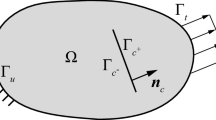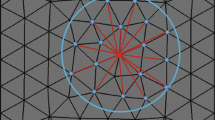Abstract
This paper presents a scheme for adaptive mesh refinement on unstructured polygonal meshes to better capture crack patterns in dynamic cohesive fracture simulations. A randomly seeded polygonal mesh leads to an isotropic discretization of the problem domain, which does not bias crack patterns, but restricts the number of paths that a crack may travel at each node. An adaptive refinement scheme is proposed and investigated through a detailed set of geometric studies. The refinement scheme is selectively chosen to optimize the number of paths that a crack may travel, while still maintaining a conforming domain discretization. The details of the refinement scheme are outlined, along with the criterion used to determine the region of refinement and the method of interpolating nodal attributes. Extrinsic cohesive elements are inserted when and where necessary, and follow the constitutive response of the Park–Paulino–Roesler cohesive model. The influence of bulk and cohesive material heterogeneity is investigated through the use of a statistical distribution of material properties. The adaptive mesh modifications are handled through a compact topological data structure. Numerical examples highlight the features of adaptive refinement in capturing physical fracture patterns while addressing computational cost. Thus, the present approach is a step towards obtaining accurate dynamic fracture patterns and fields with polygonal elements.





























Similar content being viewed by others
References
Babus̀ka I, Rheinboldt WC (1978) A-posteriori error estimates for the finite element method. Int J Numer Methods Eng 12:1597–1615
Bathe KJ (1996) Finite element procedures. Prentice Hall, Prentice
Belytschko T, Black T (1999) Elastic crack growth in finite elements with minimal remeshing. Int J Numer Methods Eng 45:601–620
Belytschko T, Chen H, Xu J, Zi G (2003) Dynamic crack propagation based on loss of hyperbolicity and a new discontinuous enrichment. Int J Numer Methods Eng 58:1873–1905
Bishop JE, Martinez MJ, Newell P (2012) A finite-element method for modeling fluid-pressure induced discrete-fracture propagation using random meshes. 46th US Rock Mechanics/Geomechanics Symposium
Bishop JE (2009) Simulating the pervasive fracture of materials and structures using randomly close packed Voronoi tessellations. Comput Mech 44:455–471
Blal N, Daridon L, Monerie Y, Pagano S (2012) Artificial compliance inherent to the intrinsic cohesive zone models: criteria and application to planar meshes. Int J Fract 178:71–83
Bolander JE, Saito S (1998) Fracture analyses using spring networks with random geometry. Eng Fract Mech 61:569–591
Celes W, Paulino GH, Espinha R (2005a) A compact adjacency-based topological data structure for finite element mesh representation. Int J Numer Methods Eng 64:1529–1556
Celes W, Paulino GH, Espinha R (2005b) Efficient handling of implicit entities in reduced mesh representations. J Comput Inf Sci Eng 5:348–359
Cerrone A, Wawrzynek P, Nonn A, Paulino GH, Ingraffea A (2014) Implementation and verification of the Park–Paulino–Roesler cohesive zone model in 3D. Eng Fract Mech. doi:10.1016/j.engfracmesh.2014.03.010
Dijkstra EW (1959) A note on two problems in connexion with graphs. Numer Math 1:269–271
Fries TP, Zilian A (2009) On time integration in the XFEM. Int J Numer Methods Eng 78:69–93
Grätsch T, Klaus-Jürgen B (2005) A posteriori error estimation techniques in practical finite element analysis. Comput Struct 83:235–265
Gravouil A, Elguedj T, Maigre H (2009) An explicit dynamics extended finite element method. Part 2: element-by-element stable-explicit/explicit dynamic scheme. Comput Methods Appl Mech Eng 198:2318–2328
Grégoire D, Maigre H, Réthoré J, Combescure A (2007) Dynamic crack propagation under mixed-mode loading—comparison between experiments and X-FEM simulations. Int J Solids Struct 44:6517–6534
Hopkinson B (1914) A method of measuring the pressure produced in the detonation of high explosives or by the impact of bullets. Proc R Soc A Math Phys Eng Sci 89(612):411–413
Hu C, Ghosh S (2008) Locally enhanced Voronoi cell finite element model (LE-VCFEM) for simulating evolving fracture in ductile microstructures containing inclusions. Int J Numer Methods Eng 76:1955–1992
Huttenlocher DP, Klanderman GA, Rucklidge WJ (1993) Comparing images using the Hausdorff distance. IEEE Trans Pattern Anal Mach Intell 15:850–863
Kalthoff JF, Winkler S (1987) Failure mode transition at high rates of shear loading. Int Conf Impact Load Dyn Behav Mater 1:185–195
Khoei AR, Azadi H, Moslemi H (2008) Modeling of crack propagation via an adaptive mesh refinement based on modified superconvergent patch recovery technique. Eng Fract Mech 75:2921–2945
Klein PA, Foulk JW, Chen EP, Wimmer SA, Gao H (2000) Physics-based modeling of brittle fracture: Cohesive formulations and the application of meshfree methods. Technical Report, Sandia National Laboratories
Leon SE, Spring DW, Paulino GH (2014) Reduction in mesh bias for dynamic fracture using adaptive splitting of polygonal finite elements. Int J Numer Methods Eng 1–23
Li S, Ghosh S (2006a) Multiple cohesive crack growth in brittle materials by the extended voronoi cell finite element model. Int J Fract 141:373–393
Li S, Ghosh S (2006b) Extended voronoi cell finite element model for multiple cohesive crack propagation in brittle materials. Int J Numer Methods Eng 65:1028–1067
Lloyd SP (1982) Least squares quantization in PCM. IEEE Trans Inf Theory 28:129–137
Miller O, Freund LB, Needleman A (1999) Energy dissipation in dynamic fracture of brittle materials. Model Simul Mater Sci Eng 6:607–638
Molinari JF, Ortiz M (2002) Three-dimensional adaptive meshing by subdivision and edge-collapse in finite-deformation dynamic-plasticity problems with application to adiabatic shear banding. Int J Numer Methods Eng 53:1101–1126
Mota A, Sun W, Ostien JT, Foulk JW, Long KN (2013) Lie-group interpolation and variational recovery for internal variables. Comput Mech 52:1281–1299
Ooi ET, Song C, Tin-Loi F, Yang Z (2012a) Polygon scaled boundary finite elements for crack propagation modelling. Int J Numer Methods Eng 91:319–342
Ooi ET, Shi M, Song C, Tin-Loi F (2012b) Automatic dynamic crack propagation modeling using polygon scaled boundary finite elements, chap 65. CRC Press, Boca Raton
Ooi ET, Shi M, Song C, Tin-Loi F, Yang ZJ (2013) Dynamic crack propagation simulation with scaled boundary polygon elements and automatic remeshing technique. Eng Fract Mech 106:1–21
Ortiz M, Pandolfi A (1999) Finite-deformation irreversible cohesive elements for three-dimensional crack-propagation analysis. Int J Numer Methods Eng 44:1267–1282
Park K, Pereira J, Duarte CA, Paulino GH (2009) Integration of singular enrichment functions in the generalized/extended finite element method for three-dimensional problems. Int J Numer Methods Eng 78:1220–1257
Park K, Paulino GH, Roesler JR (2009) A unified potential-based cohesive model for mixed-mode fracture. J Mech Phys Solids 57:891–908
Park K, Paulino GH, Celes W, Espinha R (2012) Adaptive mesh refinement and coarsening for cohesive zone modeling of dynamic fracture. Int J Numer Methods Eng 92:1–35
Paulino GH, Menezes IFM, Neto JBC, Martha LFRC (1999) A methodology and adaptive finite element analysis: towards an integrated computational environment. Comput Mech 23:361–388
Paulino GH, Celes W, Espinha R, Zhang ZJ (2008) A general topology-based framework for adaptive insertion of cohesive elements in finite element meshes. Eng Comput 24:59–78
Paulino GH, Park K, Celes W, Espinha R (2010) Adaptive dynamic cohesive fracture simulations using nodal perturbation and edge-swap operators. Int J Numer Methods Eng 84:1303–1343
Remmers JJC, de Borst R, Needleman A (2008) The simulation of dynamic crack propagation using the cohesive segments method. J Mech Phys Solids 56:70–92
Rimoli JJ, Rojas JJ (2013) Meshing strategies for the alleviation of mesh-induced effects in cohesive element models. arXiv preprint arXiv:13021162
Rimoli JJ, Rojas JJ, Khemani FN (2012) On the mesh dependency of cohesive zone models for crack propagation analysis. In: 53rd AIAA/ASME/ASCE/AHS/ASC structure, structural dynamics and materials conference, American Institute of Aeronautics and Astronautics
Rockafellar RT, Wets RJB, Wets M (1998) Variational analysis, vol 317. Springer, Berlin
Sharon E, Gross SP, Fineberg J (1995) Local crack branching as a mechanism for instability in dynamic fracture. Phys Rev Lett 74:5096–5099
Sharon E, Fineberg J (1996) Microbranching instability and the dynamic fracture of brittle materials. Phys Rev B 54:7128–7139
Strouboulis T, Babus̀ka I, Copps K (2000) The design and analysis of the generalized finite element method. Comput Methods Appl Mech Eng 181:43–69
Strouboulis T, Copps K, Babus̀ka I (2001) The generalized finite element method. Comput Methods Appl Mech Eng 190:4081–4193
Sukumar N, Malsch EA (2006) Recent advances in the construction of polygon finite element interpolants. Arch Comput Methods Eng 13:129–163
Talischi C, Paulino GH, Periera A, Menezes IFM (2012) Polymesher: a general-purpose mesh generator for polygonal elements written in Matlab. J Struct Multidiscip Optim 45:309–328
Talischi C, Paulino GH, Pereira A, Menezes IFM (2012) Polytop: a Matlab implementation of a general topology optimization framework using unstructured polygonal finite element meshes. J Struct Multidiscip Optim 3:329–357
Velho L, Gomes J (2000) Variable resolution 4-k meshes: concepts and applications. Comput Graphics Forum 19:195–212
Wachspress EL (1975) A rational finite element basis. Academic Press, New York
Weibull W (1939) A statistical theory of the strength of materials. Proc R Acad Eng Sci 151:1–45
Zhang Z, Paulino GH, Celes W (2007) Extrinsic cohesive zone modeling of dynamic fracture and microbranching instability in brittle materials. Int J Numer Methods Eng 72:893–923
Zhang Z, Paulino GH (2005) Cohesive zone modeling of dynamic failure in homogeneous and functionally graded materials. Int J Plast, special issue on “Inelastic Response of Multiphase Materials” 21:1195–1254
Zhou F, Molinari JF (2004) Dynamic crack propagation with cohesive elements: a method to address mesh dependency. Int J Numer Methods Eng 59:1–24
Zienkiewicz OC, Zhu JZ (1992a) The superconvergent patch recovery and a posteriori error estimates. Part 1: the recovery technique. Int J Numer Methods Eng 33:1331–1364
Zienkiewicz OC, Zhu JZ (1992b) The superconvergent patch recovery and a posteriori error estimates. Part 2: error estimates and adaptivity. Int J Numer Methods Eng 33:1365–1382
Acknowledgments
Daniel W. Spring, Sofie E. Leon, and Glaucio H. Paulino gratefully acknowledge the support of the Natural Sciences and Engineering Research Council of Canada, the US National Science Foundation (NSF) Graduate Research Fellowship, and the Donald B. and Elizabeth M. Willett endowment at the University of Illinois at Urbana-Champaign, respectively. We also acknowledge support from NSF through Grants #1321661 and #1437535. The authors would also like to extend their appreciation to Dr. Cameron Talischi for his advice and input to this publication.
Author information
Authors and Affiliations
Corresponding author
Rights and permissions
About this article
Cite this article
Spring, D.W., Leon, S.E. & Paulino, G.H. Unstructured polygonal meshes with adaptive refinement for the numerical simulation of dynamic cohesive fracture. Int J Fract 189, 33–57 (2014). https://doi.org/10.1007/s10704-014-9961-5
Received:
Accepted:
Published:
Issue Date:
DOI: https://doi.org/10.1007/s10704-014-9961-5




